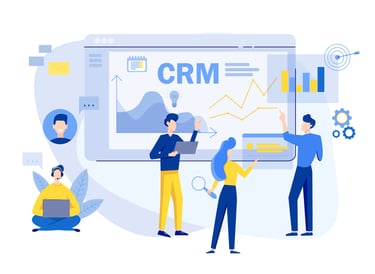Inbound Marketing Blog
for Manufacturers and Healthcare Companies
WEBINAR: 10 Ways to Foster CRM User Adoption Instead of Abandonment
(Watch the webinar above or read below -- whichever you prefer!)
CRM software, also known as customer relationship management software, is an essential tool for companies in just about every industry. It supports sales’ and marketings’ ability to drive company growth and meet goals.
But did you know that 1 in 3 of all CRM projects fail? Some stats even show that number to be 70% and up. However, this all depends on what your definition of failure is.
One of the ways we define failure is when CRM tools lack full adoption from a company, and is viewed as an extra step or hurdle that many aren’t willing to take on. And all of the resources that exist in a B2B sales toolkit, a CRM platform is not one you want to overlook.
With CRMs being such a time and money investment, why is the failure rate so high? There are a number of CRM adoption challenges that arise, such as:
- Lack of functionality
- Lack of strategy
- Lack of process change
- No top-down support
- Inability to handle the change to CRM
The list goes on, but these are some of the most common. If your company is struggling to foster CRM user adoption, or is battling company-wide abandonment of the software, then these 10 tips are for you.
10 Tips to Drive CRM User Adoption
It’s not always easy getting everyone on board for a new idea or software. Here are 10 CRM adoption best practices to get everyone in the business on the same page:
- Choose the right customer relationship tool for the job
- Strategy before build … and plan to adapt to the real world
- Avoid DIY’ing it to save money
- Get buy-in from your teams
- Maintain buy-in from leadership
- Keep clean, accurate data
- Train … and then train again
- Find your champion
- Train for efficiency and effectiveness, not inspection
- Be supportive. Change is hard
1. Choose the Right Tool for the Job
This is one of the most important aspects of CRM adoption. A tool that doesn’t fit your company’s needs, or just plain sucks, will create friction, and people won’t enjoy it or want to use it. The wrong tool will also fail to add value to your business, resulting in a waste of time, money, and effort.
Instead, think about what your company needs and which CRM tool would be the best fit for your company.
2. Strategy Before Build … And Plan to Adapt to the Real World
You don’t have to use a tool exactly how it is coming out of the box. Instead, identify what tools will be incorporated into your CRM and adjust your customer relationship management strategy as needed.
Strategies are always evolving based on customer and company needs. Therefore, you should never plan on using your CRM the same way forever -- customize it as you figure out how your teams can best leverage it.
3. Avoid DIY’ing It to Save money
If you’re setting up CRM software, avoid taking shortcuts just to save money. Even if “so and so did great with this at their last job.”
This, in theory, could work, but it may cost the company more down the road by having to inefficiently piece elements together to adjust to your team. It’s best to bring in a professional CRM trainer for at least a portion of the process to ensure smooth onboarding.
4. Get Buy-In From Your Teams
This tip is incredibly important. Team buy-ins are vital because you usually have multiple teams using the system.
The sales team, marketing team, account management team, and so on may all be involved with the CRM. It’s not mandatory that every team be integrated, but the more cohesive you can make these teams under one system, the better.
Whoever will use the system needs to support the fact that your business needs this CRM. They should advocate for the CRM and understand that it supports business growth.
5. Maintain Buy-In From Leadership
Once you have your buy-ins, it’s crucial to maintain them. This reinforces accountability.
Successfully receiving buy-in can’t be a result of leadership only needing the CRM for one or two problems, only to immediately ditch the system once the problem is resolved. Leadership needs to maintain buy-in and hold the management team accountable for using the CRM accurately and to its fullest capabilities.
6. Keep Clean, Accurate Data
Garbage in, garbage out. Take the time to ensure all your info in the CRM is clean and accurate.
Some will try and rush data input to get it finished as quickly as possible. This can cause massive delays down the road or during CRM onboarding.
7. Train … And Then Train Again
Structure your training sessions to encompass all things about the CM system. Try to answer the question: “Why are we using this?”
This answer will be different for every individual team in your company, so it’s likely that separate training will be necessary. Not only does this help employees understand their role within the CRM, it also helps them better understand their day-to-day functions in the system.
8. Find Your Champion
Regardless of how big your team is, there will always be an individual or small group that understands the CRM better than others and is having success using it. Identify these people, speak with them, and find out why it's working so well.
Also encourage them to be an advocate for the rest of the team. Allow them to be a trainer for their peers and offer the rest of your team an alternate way of learning, one that could be more effective than the management team or an outside source. This is one of the most effective CRM implementation strategies.
9. Train for Efficiency and Effectiveness, NOT Inspection
Sales and marketing teams don't want to feel like management is putting the CRM in place to monitor their activity. That’s not going to build buy-in and support, and will create frustration and fuel CRM abandonment.
It’s important to build the system and strategy to ensure your teams can do their job efficiently and effectively. After all, the entire purpose of CRM tools is to improve work productivity, not monitor it.
10. Be Supportive. Change Is Hard.
You’re all on the same team. Support each other and help one another grow during CRM training. This is especially true for co-workers who may not be as tech-savvy as others.
Always be willing to answer each other's questions, and never be ashamed to admit when you don’t know something and need additional help.
Want to Learn More?
Hopefully these 10 tips on fostering CRM user adoption were helpful and relevant to you and your company. If you want to learn more, or take an even closer look at the tips provided, then click below to gain free access to this video on-demand, and to its corresponding slides:
Our Blogs, Direct to Your Inbox!
How to Audit your Online Marketing
If you are executing digital marketing, congratulations! You are most likely already one step ahead of your competition, and making strides to meaningfully connect with prospects online. But, how do you know if you’re seeing continual success year over year, and improving your metrics?
Without the tools in place to analyze and benchmark your efforts, it is impossible to scale your online marketing and ensure continuous success.



